Automotive industry in Italy
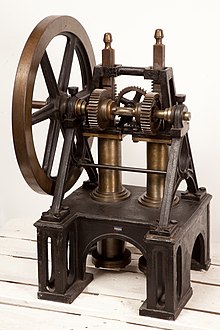
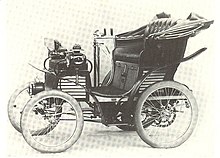
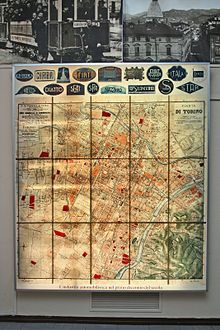
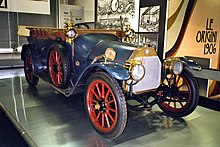
The automotive industry in Italy is a quite large employer in the country, it had over 2,131 firms and employed almost 250,000 people in 2006.[1] Italy's automotive industry is best known for its automobile designs and small city cars, sports and supercars. The automotive industry makes a contribution of 8.5% to Italian GDP.[2]
Italy is one of the significant automobile producers both in Europe and around the world.
Today the Italian automotive industry is almost totally dominated by Stellantis (formerly called Fiat Group); in 2001 over 90% of vehicles were produced by it. As well as its own, predominantly mass market model range, Stellantis owns the mainstream Fiat brand, the upmarket Alfa Romeo and Lancia brands, and the exotic Maserati brand.
Italian cars won in the European Car of the Year annual award one of the most times among other countries (including Fiat most that any other manufacturer with Fiat 124, Fiat 128, Fiat Uno, Fiat Tipo and others) and in World Car of the Year award also.[3]
Brand
[edit]History
[edit]
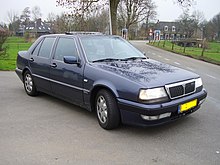

The Barsanti-Matteucci engine was the first invented internal combustion engine using the free-piston principle in an atmospheric two cycle engine.[4][5] In late 1851 or early 1852 Eugenio Barsanti, a professor of mathematics, and Felice Matteucci, an engineer and expert in mechanics and hydraulics, joined forces on a project to exploit the explosion and expansion of a gaseous mix of hydrogen and atmospheric air to transform part of the energy of such explosions into mechanical energy.
The Italian automotive industry started in the late 1880s, with the Stefanini-Martina regarded as the first manufacturer[6] although Enrico Bernardi had built a petrol fueled tri-cycle in 1884.
In 1888 Giovanni Battista Ceirano started building Welleyes bicycles, so named because English names had more sales appeal,[7] and in October 1898 he co-founded Ceirano GB & C with his brothers Matteo, and Ernesto to build the Welleyes motor car. As they encountered challenges of scale and finance they contacted a consortium of local nobility and business-men led by Giovanni Agnelli and in July 1899 Fiat SpA purchased the plant, design and patents – so producing the first F.I.A.T. – the Fiat 4 HP. The Welleyes / F.I.A.T 4 HP had a 679 cc engine and was capable of 35 km/h (22 mph).[8]
Isotta Fraschini, a Italian luxury car manufacturer, was founded in 1900 at first assembling Renault model automobiles. It was founded in Milan by Cesare Isotta and the brothers Vincenzo, Antonio, and Oreste Fraschini. The firm was named for its founders, Cesare Isotta and Vincenzo Fraschini, who had been importing Mors and Renault automobiles as well as Aster proprietary engines since 1899.[9] Prior to establishing their own products in 1904, Isotta and Fraschini assembled cars very similar to Renaults, with Aster engines. They differed from the real Renaults in having a neater underslung front radiator arrangement.[10] The first automobile bearing this marque featured a four-cylinder engine with an output of 24 horsepower (18 kW).
Alfa Romeo was founded on 24 June 1910 in Milan as A.L.F.A—an acronym for Anonima Lombarda Fabbrica Automobili. The company was established by Cavaliere Ugo Stella to acquire the assets of the ailing Italian subsidiary of French carmaker Darracq, of which he had been an investor and manager.[11] Its first car was the 24 HP, designed by Giuseppe Merosi, which became commercially successful and participated in the 1911 Targa Florio endurance race. In August 1915, ALFA was acquired by Neapolitan entrepreneur and engineer Nicola Romeo, who vastly expanded the company's portfolio to include heavy machinery and aircraft engines. In 1920, the company's name was changed to Alfa Romeo, with the Torpedo 20–30 HP being the first vehicle to bear the new brand.
Lancia was founded in 1906 in Turin by Vincenzo Lancia and Claudio Fogolin. It became part of Fiat in 1969. The brand is known for its strong rallying heritage, and technical innovations such as the unibody chassis of the 1922 Lambda and the five-speed gearbox introduced in the 1948 Ardea.[12] Maserati was established in 1914 in Bologna.[13] The company's headquarters are now in Modena, and its emblem is a trident. The automobile industry grew quickly and manufacturers included Aquila Italiana, Fratelli Ceirano, Diatto, Itala, Junior, Società Ceirano Automobili Torino, S.T.A.R. Rapid, SPA, and Zust. During the first and the second World Wars and the economic crisis of the 1970s, many of these brands disappeared or were bought by FIAT or foreign manufacturers.
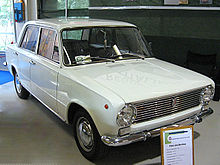
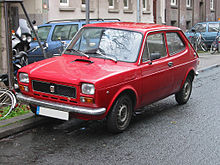
Over the years, the Italian automobile industry has also been involved in numerous enterprises outside Italy, many of which have involved the production of Fiat-based models, including Lada in Russia, Zastava and Yugo in the former Yugoslavia, FSO (Polski Fiat) in Poland and SEAT (now part of Volkswagen) in Spain.
In the 1960s and 1970s, Italy restored its own large auto industry that was 3rd or 4th in Europe and 5th or 6th in the World. In the 1980s, Italy overtook the United Kingdom but conceded to the Soviet Union which, like Spain, Poland and Yugoslavia, began large-volume production of cars with Italian FIAT help.
The 1970s and 1980s were a time of great change for the car industry in Europe. Rear-wheel drive, particularly on family cars, gradually gave way to front-wheel drive. The hatchback bodystyle, first seen on the Renault 16 from France in 1965, became the most popular bodystyle on smaller cars by the mid-1980s. Fiat moved into the hatchback market at the small car end in 1971 with the 127 hatchback, followed by the Ritmo family car in 1978. By the end of the decade, the more upmarket Alfa Romeo and Lancia marques had also added hatchbacks to their ranges. The Italian motor industry's flair for innovative design continued in the 1980s, with its Uno supermini (1983) and Tipo family hatchback (1988) both being voted European Car of the Year mostly in recognition of their up-to-date and practical designs. The Uno was one of the most popular cars in Europe throughout its production life, although the Tipo was not so popular outside Italy.
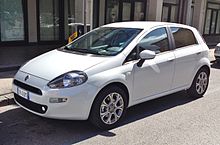
The Uno's replacement, the Punto, was launched at the end of 1993 and achieved success similar to that of its predecessor, while its earlier Cinquecento played a big part in boosting the size of the city car sector in Europe during the 1990s. Fiat entered the new compact MPV market in 1998 with the quirky six-seater Multipla, having already entered the full size MPV market halfway through the decade with the Eurovan as part of a joint venture with Peugeot.
In the 1990s, the Italian auto industry again was 3rd in Europe and 5th in World with an annual output near 2 million (with 2,220,774 maximum in 1989). In 2011, however, it fell below 800,000 for the first time in half a century and is now 6th place in Europe and 19st place in the World.[16][17][18]
Italy today remains one of the significant players of car design and technology, and Fiat has large investments outside Italy including a 100% stake in the American automaker Chrysler as of January 2014. Fiat's fortunes have been helped since 2007 by the huge success across Europe of its new Fiat 500 city car, although the 500 is manufactured in Poland and Mexico, rather than in Italy.
Production figures
[edit]




Italian motor vehicle production[16][17][18][19]
| Year | Units |
|---|---|
| 1913 | 2,000 |
| 1924 | 35,000 |
| 1928 | 55,000 |
| 1935 | 44,000 |
| 1950 | 129,000 |
| 1960 | 645,000 |
| 1961 | 759,000 |
| 1970 | 1,854,252 |
| 1971 | 1,817,000 |
| 1980 | 1,610,287 |
| 1981 | 1,433,000 |
| 1989 | 2,220,774 |
| 1990 | 2,120,850 |
| 1991 | 1,878,000 |
| 1994 | 1,534,000 |
| 1995 | 1,667,000 |
| 1996 | 1,545,000 |
| 1997 | 1,827,592 |
| 1998 | 1,692,737 |
| 1999 | 1,704,326 |
| 2000 | 1,741,478 |
| 2001 | 1,581,908 |
| 2002 | 1,429,678 |
| 2003 | 1,324,481 |
| 2004 | 1,145,181 |
| 2005 | 1,038,352 |
| 2006 | 1,211,594 |
| 2007 | 1,284,312 |
| 2008 | 1,023,774 |
| 2009 | 843,239 |
| 2010 | 838,400 |
| 2011 | 790,348 |
| 2012 | 671,768 |
| 2013 | 658,206 |
| 2014 | 697,864 |
| 2015 | 1,014,223 |
| 2016 | 1,103,516 |
| 2017 | 1,142,210 |
| 2018 | 1,060,068 |
| 2019 | 915,305 |
Manufacturers
[edit]Current manufactures
[edit]Italian current automobile manufacturers include:
Defunct manufacturers
[edit]Defunct manufacturers:
- APIS
- Aquila
- Amilcar Italiana
- Ansaldi
- Ansaldo
- Aurea
- ATS
- ASA
- Autobianchi
- Bandini
- Bertone
- Bianchi
- Bizzarrini
- Brixia-Zust
- Ceirano
- Ceirano GB & C
- Fratelli Ceirano & C.
- Ceirano Junior & C.
- Ceirano Fabbrica Automobili or Giovanni Ceirano Fabbrica Automobili
- Chiribiri
- Cisitalia
- Cizeta
- Colli
- CMN
- De Tomaso
- De Vecchi
- Diatto
- Fabrica Anonima Torinese Automobili (FATA)
- FOD
- Fabbrica Ligure Automobili Genova F.L.A.G. (aka FLAG)
- Florentia
- Ghia
- Gecav
- IENA
- Innocenti
- Intermeccanica
- Iso
- Itala
- Maggiora
- Martin
- Moretti
- Ufficine Nardi
- OM
- Osca
- OSI
- Qvale
- Società Torinese Automobili Rapid (S.T.A.R.) badged as Rapid
- S.C.A.T. (SCAT)
- S.C.A.T.-Ceirano
- Serenissima
- Siata
- S.P.A. (SPA)
- Stanguellini
- S.T.A.R. - badged as Rapid
- Storero
- Zust
See also
[edit]References
[edit]- ^ "ITALY'S AUTOMOTIVE INDUSTRY IS BACK ON THE ROAD THANKS TO EXPORTS". italtrade.com. Archived from the original on 11 January 2008. Retrieved 2008-02-06.
- ^ "Country Profiles > ITALY". acea.thisconnect.com. Archived from the original on 11 February 2008. Retrieved 2008-02-09.
- ^ "Every European Car of the Year (COTY) winner since 1964". The Telegraph. 2020-03-02. ISSN 0307-1235. Retrieved 2023-06-20.
- ^ "The Historical Documents". Barsanti e Matteucci. Fondazione Barsanti & Matteucci. 2009. Archived from the original on 2017-02-25. Retrieved 2013-11-01.
- ^ Ricci, G.; et al. (2012). "The First Internal Combustion Engine". In Starr, Fred; et al. (eds.). The Piston Engine Revolution. London: Newcomen Society. pp. 23–44. ISBN 978-0-904685-15-2.
- ^ "Other European developments". britannica.com. Archived from the original on 2 January 2008. Retrieved 2007-12-23.
- ^ "Lancia, the essentials". Archived from the original on 2011-02-24. Retrieved 2014-04-24.
- ^ "The history of Fiat". carsfromitaly.net. Retrieved 2007-12-23.
- ^ Nicholson, Tim (May 1971), Isotta-Fraschini: the noble pride of Italy, New York, NY: Ballantine Books Inc., p. 18, ISBN 0-345-02289-0
- ^ Nicholson, p. 19
- ^ "Alfa Romeo Celebrates 90 Years of Success". autoweb.com. 2000. Archived from the original on 11 May 2009. Retrieved 9 January 2009.
- ^ Malan, Andrea (19 October 2019). "Lancia passes Fiat ownership landmark but no celebration for storied brand". Automotive News Europe. Retrieved 18 April 2020.
- ^ "Company history". maserati.com. Retrieved 24 July 2014.
- ^ "Fiat Punto: sucesso no Brasil e no mundo". fiatpress.com. Archived from the original on 6 March 2016. Retrieved 2 May 2013.
- ^ "Fiat Punto 2012: the evolution of a best seller". fcapress.com.br. Retrieved 8 May 2013.
- ^ a b OICA: Production Statistics
- ^ a b Ward's: World Motor Vehicle Data 2007. Wards Communications, Southfield MI 2007, ISBN 0910589534
- ^ a b RITA. Table 1-23: World Motor Vehicle Production, Selected Countries Archived 2017-07-29 at the Wayback Machine
- ^ J. Bradford DeLong. "Slouching Towards Utopia?: The Economic History of the Twentieth Century". econ161.berkeley.edu. Archived from the original on 2008-05-09. Retrieved 2008-02-06.



